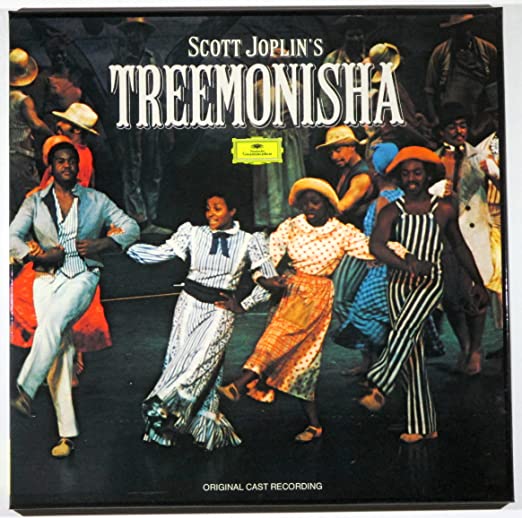Treemonisha: Difference, Power, and Music
In the opera Treemonisha, by Scott Joplin, there is difference and power displayed in the music of the quintet that begins Act 1 (“The Bag of Luck”) and throughout the whole number.

Introduction
The quintet that begins Act 1 (“The Bag of Luck”) portrays the ways in which Joplin exemplifies Treemonisha in the actual music. This lengthy ensemble introduces each of the main characters of the opera and serves as a harmonic masterpiece as the characters interact with one another, while “competing” against the villain Zodzetrick. Lastly, this number features all five main characters (Zodzetrick, the villain; Treemonisha, our heroine; Monisha, her mother; Ned, her father; and Remus, her friend and pupil). However, Zodzetrick and Treemonisha are the focus.
Difference
In act 1, there are two different musical issues present by Joplin. First, there are fully diminished seventh chords and a flat submediant. Second, Joplin relies on his libretto and specific musical techniques to present a strong depiction of the Black womanhood in his characterization of Treemonisha. Moreover, Joplin uses the fully diminished seventh chord to contrast the characters of Zodzetrick and Treemonish. These two characters are the main focus in the quintet that begins Act 1 (“The Bag of Luck”). Zodzetrick sings longer and has a large number of assertive cadences. Therefore, he holds more power. Treemonisha depicts a more “proper” acquiescent female heroine since she has two brief solo phrases and ends on the dominant seventh chord.
Zodzetrick is the first to enter, so he is the first voice heard in the opera. He seems to control the music well in comparison with the other characters, and he sings longer than the others in quintet. In contrast, Treemonisha does not appear until measure 68, well into the quintet. She also has significantly less musical material in this act in comparison to Zodzetrick.
In continuation, Treemonisha’s music markedly differs from Zodzetrick’s. First, her music avoids the diminished seventh chord. Over the entire number, only four diminished seventh chords occur while she sings. Three of these are heard when she addresses Zodzetrick directly.
Zodzetrick has speech-like, largely melodic lines. However, his vocal lines avoid leaps larger than a fifth. In contrast, Treemonisha has an exhilarating, crystalline soprano range, including leaps of a sixth. Her vocal lines skyrocket up to as and b-flats in the five octave. Moreover, Treemonisha’s solo phrases are in the keys of E-flat and B-flat.
Power
Joplin uses two different types of music in Treemonisha, the flat submediant and the fully diminished seventh chords. As well as these different types of music, Joplin also uses and heavily relies on particular music techniques to get the differences across with the characters.
Zodzetrick is immediately established to be the villain in the musical. Therefore, Joplin uses different music techniques to establish differences between the characters, especially for Zodzetrick. In act one, Joplin uses wary music when Zodetrick enters the stage, and by doing this, it gives him the power of the villain. Similarly, anytime another character comes into contact with Zodzetrick, there is a change in the music, often putting off a curious or scared ambiance.
The same way that Zodzetrick has wary music, the heroine, Treemonisha, has visibly different music styles because of the role she played within the musical. It is important to realize this because of Treemonisha’s obviously pragmatic music. She has a more pragmatic aura than Zodzetrick.
Music
Music plays a major role in how an audience perceives a character in a musical. In the song “The Bag of Luck,”Joplin strategically uses a G#º7/D (G sharp fully diminished seventh chord in second inversion) to introduce Zodzetrick by name. His name is said on the page 26 of “Uplift, Gender, and Scott Joplin’s Treemonisha” by Rachel Lumsden in the anacrusis (pick up) before measure 56. One would not use a chord as dark and powerful as this one for the recognition of a happy/positive-minded heroine like Treemonisha or any harmless ensemble member in a show. This chord acknowledges that Zodzetrick may be somewhat of a sneaky and conniving character to stay clear of and avoid at any costs, and later in this piece, we are let known of his truly forceful intentions. He exits, warning them to anticipate his return. See below for a visual representation.
Towards the end of number, in the song, “We Will Trust You As Our Leader,” the community (chorus) sings, “You should lead us now, please lead us.” Joplin places emphasis on Treemonisha’s response by making the word “lead” on an F natural. Joplin conveyed Treemonisha’s uncertainty to lead her community. This is the flat 6th scale degree of the key A major in comparison to the more confident F sharp later in the piece, “Yes I will lead you” and with “you”ending on a triumphant A natural. A slight change of pitch musically captures her brave position towards the situation at the end of the number.
Moreover, the traditional overture to this opera is very unorthodox from those typical of European Opera because of the unique ragtime syncopated rhythm in the right hand, while the bass keeps straight eighth notes.

Conclusion
Overall, there are specific musical strategies in order to sharply differentiate between Zodzetrick and Treemonisha. Treemonisha has an upright, purity, and erudition emphasized by her constant and virtuosic melodic lines. However, she avoids the swiftness and ambiguity of the inharmonious diminished seventh sonority associated with Zodzetrick.
Works Cited
Lumsden, Rachel. “Uplift, Gender, and Scott Joplin’s Treemonisha.” Black Music Research Journal, vol. 35, no. 1, 2015, pp. 41–69. JSTOR, www.jstor.org/stable/10.5406/blacmusiresej.35.1.0041. Accessed 11 Mar. 2021.
More Posts by the Authors

Is Hip-Hop the New Gospel?
For years, the Gospel genre of music has provided a way for people to maintain balance in their lives. With every life lesson in the

The Two Waves of Detroit Techno Music: Techno and Rave!
The Two Waves of Detroit Techno Music: Techno and Rave! Techno, house, and rave (electro) are the primary forms of electronic music in Detroit. Though
The Symbolism Behind Negro Spirituals
It has always been apparent that songs more often than not have deeper meanings embedded in them. Whether it be metaphors, figurative language, or hidden
Jubilee Quartets in the World of HBCUs
Jubilee Quartets in the World of HBCUs What is a Jubilee Quartet? There is much scpeculation regarding where the Jubilee Quartet originated from, but it
Women of the Blues: Bessie Smith
Women of the Blues: Bessie Smith The Blues genre did not only include black men. Black Women significantly contributed to the sound of the blues.

